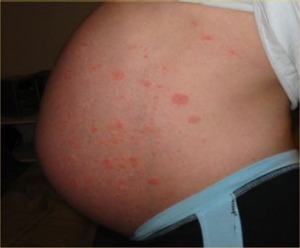
What is it?
Pruritic urticarial papules and plaques of pregnancy (PUPPP) is a rash that occurs in pregnancy. The rash is extremely itchy and can cause intense discomfort to the mum-to-be, but the baby isn’t affected.
PUPPP is the most common pregnancy-related skin condition, but it's not known exactly how many women get it. Estimates vary from one in 100 to one in 300 pregnancies.
PUPPP usually affects women in the last few weeks of pregnancy, but in some cases, it can start immediately after the birth. It seems to be more common in first-time mothers and those carrying multiples.
The exact cause of the skin condition is unknown, but certain studies suggest foetal cells migrate to the mother’s skin, causing inflammation.
In the United Kingdom, the condition is known as polymorphic eruption of pregnancy (PEP).
What are the symptoms?
This extremely itchy rash can cause wheals/welts, small raised lumps, and large, red inflamed areas. It usually starts within stretch marks (if they’re present) on the abdomen, and can spread to the thighs, buttocks and arms. Less commonly, it affects the face, palms, and soles of the feet.
If other symptoms are present (including dark urine, pale stools, urinary tract infections or fevers), it could be a sign of another condition, such as obstetric cholestasis. If you have any of these symptoms in addition to the rash or itch, see your doctor.
How is it diagnosed?
There is no diagnostic test for PUPPP. Your GP or obstetrician can examine the skin and suggest consultation with a dermatologist. They can also request skin biopsies and blood tests to rule out other conditions.
What’s the treatment?
There’s no cure for PUPPP. Usually, the rash lasts until several weeks after birth; it then disappears, leaving no scars.
To treat the symptoms, sufferers can:
- try calamine lotion, aloe vera gel or an oatmeal bath
- speak to their doctor or chemist about pregnancy-safe topical steroids or oral antihistamines
- wear cotton clothes
- wear gloves (this can stop excessive scratching, which can lead to infection)
- avoid warm baths, soap-based cleansers and excessive exposure to the sun – these can all aggravate the rash.
Other issues
For more severe cases, stronger steroids may be recommended. If the sufferer takes oral steroids, careful observation – including monitoring foetal size, maternal blood pressure and blood tests – may be necessary.
Alternatively, an early induction may be suggested, based on maternal and foetal health. Doctors rarely recommend a caesarean based on this condition alone.
After birth, it’s generally okay to breastfeed the baby, even if the rash is still present.
It’s unusual for the woman to develop the rash in subsequent pregnancies.
Facts verified by Dr. Gino Pecoraro. Dr. Pecoraro is a Brisbane-based obstetrician and gynaecologist.
For pregnancy support, check out the discussions in the Essential Baby forum. You can also join a group of women who are due at the same time as you.